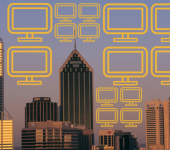Sustainability and green tech solutions are not just buzz words or a passing fad, in recent years the awareness of echo-friendly sustainable efforts on behalf of the corporate world have become common, and even mandatory, practice. Large companies and corporations have many areas in which they can demonstrate environmental awareness and practice green tech – the following are five categories that lead the way for those seeking to implement proper green tech solutions:
1. Green Data Centers: Organizations with large computer networks, processing large amounts of data, have to maintain central data centers. The U.S. Dept. of Energy stated that data centers can consume up to 100 to 200 times more energy than the standard office building. These data centers can easily become environmentally friendly through green design and architectural efforts. Data centers consume large amounts of energy as we’re basically talking about a huge hub of computers working 24/7, so a good place to start would be in managing all the related electricity consumption around these computers. Energy management plans can be set up for the data center’s general electricity and lighting systems, and creative echo-friendly techniques, like utilizing natural air and water cooling systems, can be used to keep the computers from over-heating, delaying the need to turn on electricity powered cooling systems. A popular technique used in green data centers is renewable energy, powered by solar and wind. Another solution is motion sensors paired with LED lighting, set to turn on only as needed, when people arrive on the premises.
2. Green Office Cooling Solutions: The growing awareness of green efforts in the construction sector have led to the adoption of natural heating & cooling solutions in both residential and office buildings, aimed at lowering the use of air conditioning systems. Green heating & cooling systems are categorized as either active or passive. Passive systems are based on solutions that maximize the use of natural resources to heat or cool without using furnaces or air conditioners. These solutions include (i) minimizing the heating affects of solar radiation in the summer by installing absorbing solar panels and specially coated windows; (ii) planting “green roofs” – evaporation from the rooftop vegetation keeps the roof cool and minimizes heat entering the building below; (iii) “evaporative cooling” systems that humidify the air with water and distribute the cooled air with fans, which use less energy than refrigeration cooling systems; (iv) geothermal pumps that take advantage of the constant temperature of underground wells, pumping fluids that absorb the Earth’s heat in order to keep the indoors warm during the winter, or bring down the temperature during the summer; (v) ice! Among the many great new eco-friendly companies of recent years is Ice Energy, offering air cooling units that create ice during the night and use it to cool the warmer air during the day, a process which uses significantly less electricity to cool the premises during peak heat hours.
3. Green IT Storage Services: Cloud-based storage is among the more popular green tech solutions, as it means less on-site equipment and significant savings on the energy that would have been needed to run these additional hardware storage units. Companies that decide to go green by turning to the cloud, often go beyond storage solutions and move many of their computing services to the cloud. Small to large businesses can significantly reduce direct energy consumption and carbon emissions by moving specific on-site applications to the cloud.

4. Green Printing: From eco-friendly ink to paper options, green printing can go a long way if you consider the following: (i) a double-sided printing policy whenever possible can cut a company’s paper consumption by half; (ii) using recycled paper can have a significant positive impact on a company’s environmental footprint; (iii) using refillable ink cartridges; (iv) moving to digitized documents and offering online-first communication procedures to customers and colleagues; (v) implementing internal company workflows based on workflow management software, eliminating paper-based processes; and last but not least, (vi) if your company is willing to go all-out – soy-based ink releases less than 5% Volatile Organic Compounds into the air, helps towards paper recycling as it’s easier to remove from paper than regular ink, and less ink is needed to print the same amount of pages, when compared to petroleum ink.
5. Green PC Power Management Solutions: A major culprit in unnecessary energy consumption is a company’s computer network, which can boast hundreds to thousands of computers that stay powered on overnight, over the weekend, and in general – 24/7. Employees tend to leave their computers on overnight in case they’ll need to access them remotely from home, or in some cases – IT teams request that computers be kept on in order to run maintenance tasks and updates during non-office hours. In cases like these, standard one-size-fits-all power management solutions aren’t useful. If IT managers want to properly manage their network’s power consumption they need to implement a power management solution that is built especially for large scale networks with individual maintenance needs. One of the solutions offered on the market today is PowerPlug Pro, a simple-to-implement software solution that enables smart management and monitoring of thousands of PCs, creates tailored power savings plans, enables remote wakeup of shutdown PCs, and helps companies achieve overall savings of up to 60% on PC network energy costs, without affecting IT productivity. In general, a good PC power management solution will not only cut costs and reduce environmental impact, but will also serve as a crucial resource for IT managers.





